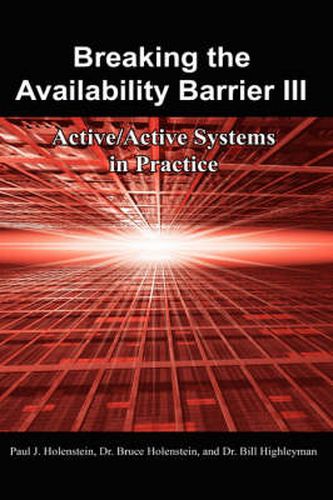Readings Newsletter
Become a Readings Member to make your shopping experience even easier.
Sign in or sign up for free!
You’re not far away from qualifying for FREE standard shipping within Australia
You’ve qualified for FREE standard shipping within Australia
The cart is loading…






This title is printed to order. This book may have been self-published. If so, we cannot guarantee the quality of the content. In the main most books will have gone through the editing process however some may not. We therefore suggest that you be aware of this before ordering this book. If in doubt check either the author or publisher’s details as we are unable to accept any returns unless they are faulty. Please contact us if you have any questions.
Active/active architectures can extend failure times from years to centuries. Active/active systems comprise multiple independent nodes using a common distributed database cooperating in a common application. This book is the third volume of a three-part series on active/active systems. It gives real-life examples of existing active/active systems that are achieving such extraordinary failure intervals. As our daily lives and corporate well-being become more dependent upon computers, system reliability grows increasingly important. No longer are frequent system outages acceptable. Often, failure intervals must now be measured in centuries. In addition, the performance of these systems is analyzed; and a set of commercial off-the-shelf products are described that enable system implementations. There are many additional advantages of these multi-node architectures, such as unlimited scalability, load balancing, disaster tolerance, efficient use of all capacity, and risk-free failover testing. Also described are several other technologies related to high availability, such as the grid, virtual tape, and the Real Time Enterprise (RTE). There are many regulations being promulgated that require the use of high-availability computing. Many of these are summarized. Throughout this volume and the preceding two volumes, dozens of rules are formulated to achieve extreme availabilities. They are summarized here for handy reference.
$9.00 standard shipping within Australia
FREE standard shipping within Australia for orders over $100.00
Express & International shipping calculated at checkout
This title is printed to order. This book may have been self-published. If so, we cannot guarantee the quality of the content. In the main most books will have gone through the editing process however some may not. We therefore suggest that you be aware of this before ordering this book. If in doubt check either the author or publisher’s details as we are unable to accept any returns unless they are faulty. Please contact us if you have any questions.
Active/active architectures can extend failure times from years to centuries. Active/active systems comprise multiple independent nodes using a common distributed database cooperating in a common application. This book is the third volume of a three-part series on active/active systems. It gives real-life examples of existing active/active systems that are achieving such extraordinary failure intervals. As our daily lives and corporate well-being become more dependent upon computers, system reliability grows increasingly important. No longer are frequent system outages acceptable. Often, failure intervals must now be measured in centuries. In addition, the performance of these systems is analyzed; and a set of commercial off-the-shelf products are described that enable system implementations. There are many additional advantages of these multi-node architectures, such as unlimited scalability, load balancing, disaster tolerance, efficient use of all capacity, and risk-free failover testing. Also described are several other technologies related to high availability, such as the grid, virtual tape, and the Real Time Enterprise (RTE). There are many regulations being promulgated that require the use of high-availability computing. Many of these are summarized. Throughout this volume and the preceding two volumes, dozens of rules are formulated to achieve extreme availabilities. They are summarized here for handy reference.